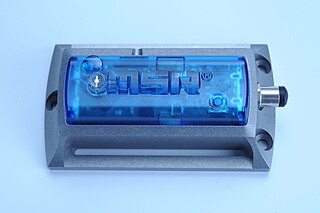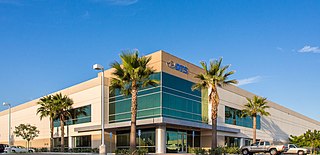
Telemetry is the in situ collection of measurements or other data at remote points and their automatic transmission to receiving equipment (telecommunication) for monitoring. The word is derived from the Greek roots tele, 'remote', and metron, 'measure'. Systems that need external instructions and data to operate require the counterpart of telemetry: telecommand.

An intelligent transportation system (ITS) is an advanced application which aims to provide innovative services relating to different modes of transport and traffic management and enable users to be better informed and make safer, more coordinated, and 'smarter' use of transport networks.
Flow measurement is the quantification of bulk fluid movement. Flow can be measured using devices called flowmeters in various ways. The common types of flowmeters with industrial applications are listed below:

A tachometer is an instrument measuring the rotation speed of a shaft or disk, as in a motor or other machine. The device usually displays the revolutions per minute (RPM) on a calibrated analogue dial, but digital displays are increasingly common.

A radar speed gun, also known as a radar gun, speed gun, or speed trap gun, is a device used to measure the speed of moving objects. It is commonly used by police to check the speed of moving vehicles while conducting traffic enforcement, and in professional sports to measure speeds such as those of baseball pitches, tennis serves, and cricket bowls.

Speed bumps are a class of traffic calming devices that use vertical deflection to slow motor-vehicle traffic in order to improve safety conditions. Variations include the speed hump, speed cushion, and speed table.
Floating car data (FCD) in traffic engineering and management is typically timestamped geo-localization and speed data directly collected by moving vehicles, in contrast to traditional traffic data collected at a fixed location by a stationary device or observer. In a physical interpretation context, FCD provides a Lagrangian description of the vehicle movements whereas stationary devices provide an Eulerian description. The participating vehicle acts itself consequently as a moving sensor using an onboard GPS receiver or cellular phone. The most common and widespread use of FCD is to determine the traffic speed on the road network. Based on these data, traffic congestion can be identified, travel times can be calculated, and traffic reports can be rapidly generated. In contrast to stationary devices such as traffic cameras, number plate recognition systems, and induction loops embedded in the roadway, no additional hardware on the road network is necessary.

A data logger is an electronic device that records data over time or about location either with a built-in instrument or sensor or via external instruments and sensors. Increasingly, but not entirely, they are based on a digital processor, and called digital data loggers (DDL). They generally are small, battery-powered, portable, and equipped with a microprocessor, internal memory for data storage, and sensors. Some data loggers interface with a personal computer and use software to activate the data logger and view and analyze the collected data, while others have a local interface device and can be used as a stand-alone device.
Weigh-in-motion or weighing-in-motion (WIM) devices are designed to capture and record the axle weights and gross vehicle weights as vehicles drive over a measurement site. Unlike static scales, WIM systems are capable of measuring vehicles traveling at a reduced or normal traffic speed and do not require the vehicle to come to a stop. This makes the weighing process more efficient, and, in the case of commercial vehicles, allows for trucks under the weight limit to bypass static scales or inspection.

A defect detector is a device used on railroads to detect axle and signal problems in passing trains. The detectors are normally integrated into the tracks and often include sensors to detect several different kinds of problems that could occur. Defect detectors were one of the inventions which enabled American railroads to eliminate the caboose at the rear of the train, as well as various station agents placed along active routes to detect unsafe conditions. The use of defect detectors has since spread overseas to other railroad systems.

VASCAR is a type of device for calculating the speed of a moving vehicle. The first VASCAR device was created in 1966 by Arthur Marshall. It is used by police officers to enforce speed limits, and may be preferred where radar or lidar is illegal, such as some jurisdictions in Pennsylvania, or to prevent detection by those with radar detectors.

A weigh station is a checkpoint along a highway to inspect vehicular weights and safety compliance criteria. Usually, trucks and commercial vehicles are subject to the inspection.
Road speed limit enforcement in Australia constitutes the actions taken by the authorities to force road users to comply with the speed limits in force on Australia's roads. Speed limit enforcement equipment such as speed cameras and other technologies such as radar and LIDAR are widely used by the authorities. In some regions, aircraft equipped with VASCAR devices are also used.
Direct TPMS, or direct tire pressure monitoring systems refers to the use of a pressure sensor directly mounted on the wheels or tires of a vehicle. The pressure inside the tire is measured using a pressure transducer with the pressure information being subsequently sent to the vehicle to warn the driver of under or over inflation of a tire. The pressure information is commonly transmitted to the vehicle using radio frequency (RF) technology, though systems using mechanical, electrical or magnetic methods have been used over recent years.

A traffic count is a count of vehicular or pedestrian traffic, which is conducted along a particular road, path, or intersection. A traffic count is commonly undertaken either automatically, or manually by observers who visually count and record traffic on a hand-held electronic device or tally sheet. Traffic counts can be used by local councils to identify which routes are used most, and to either improve that road or provide an alternative if there is an excessive amount of traffic. Also, some geography fieldwork involves a traffic count. Traffic counts provide the source data used to calculate the Annual Average Daily Traffic (AADT), which is the common indicator used to represent traffic volume. Traffic counts are useful for comparing two or more roads, and can also be used alongside other methods to find out where the central business district (CBD) of a settlement is located. Traffic counts that include speeds are used in speed limit enforcement efforts, highlighting peak speeding periods to optimise speed camera use and educational efforts.

International Road Dynamics Inc. is a road traffic management system engineering company headquartered in Saskatoon, Saskatchewan, Canada. Its services include automated toll roads, commercial vehicle inspection systems, traffic data collection products, and traffic management software.

Lidar has a wide range of applications; one use is in traffic enforcement and in particular speed limit enforcement, has been gradually replacing radar since 2000. Current devices are designed to automate the entire process of speed detection, vehicle identification, driver identification and evidentiary documentation.
RACELOGIC Ltd is a technology company based in Buckingham, United Kingdom.

A shock data logger or vibration data logger is a measurement instrument that is capable of autonomously recording shocks or vibrations over a defined period of time. Digital data is usually in the form of acceleration and time. The shock and vibration data can be retrieved, viewed and evaluated after it has been recorded.

DTS (Diversified Technical Systems) is an American manufacturer of miniature, rugged, data acquisition systems and sensors for product and safety testing in extreme environments. DTS products, made in the U.S., are used in multiple industries including automotive, aerospace, military and defense, industrial, and sports and injury biomechanics. DTS was founded in 1990 by three crash test engineers: Mike Beckage, Steve Pruitt, and Tim Kippen. The company is headquartered in Seal Beach, California, with technical centers in Michigan, Europe, Japan, China, Korea, and Asia Pacific.














